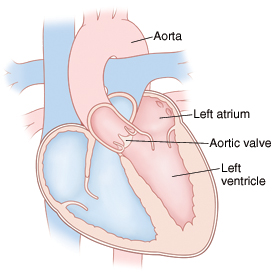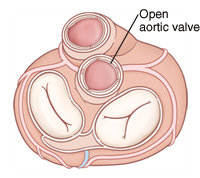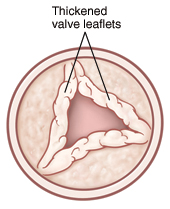When Your Child Has Aortic Stenosis (AS)
When Your Child Has Aortic Stenosis (AS)
The heart is divided into 4 chambers. The 2 upper chambers are called atria and the 2 lower chambers are called ventricles. The heart contains 4 valves. The valves open and close to keep blood flowing forward through the heart. The aortic valve is located between the left ventricle and the aorta. It has 3 leaflets that open and close to allow blood through. It controls the flow of blood from the heart to the rest of the body (except for the lungs). Aortic stenosis (AS) occurs when this valve doesn’t open all the way. It can also occur when the area above or below the valve is too narrow. As a result, blood flow from the heart to the rest of the body is blocked. Untreated, this condition can lead to certain heart problems over time. But good treatments are usually available.
Types of aortic stenosis
AS can be described as:
Supravalvar, when blockage occurs above the valve (the aorta may be too narrow).
Valvar, when blockage occurs at the valve (leaflets may be too thick, stuck together, or one or more leaflets may be absent).
Subvalvar, when blockage occurs below the valve (area below the valve may be too narrow).
What causes aortic stenosis?
In most cases, AS is a congenital heart defect. This means that your child is born with this abnormal heart structure. It can be the only defect, or it can be part of a more complex set of defects. The exact cause is unknown, but most cases seem to occur by chance. Having a family history of left-sided heart defects can be a risk factor.
Why is aortic stenosis a problem?
AS forces the left ventricle to work harder to pump blood through the aortic valve into the aorta to reach the body. This causes the left ventricle to thicken (hypertrophy) and get larger. Over time, the left ventricle can become so overworked that it no longer pumps blood well. This condition is known as congestive heart failure (CHF).
In severe cases of AS, blood flow to the coronary arteries can be reduced causing chest pain or heart attack.
Children with valve problems such as AS may be at risk of developing an infection of the inner liningof the heart or the heart valves. This infection is called infective endocarditis.
What are the symptoms of aortic stenosis?
Children with mild or moderate AS can appear to be in normal health and have no symptoms. Children with severe or critical AS will usually have symptoms. These can include:
Low blood pressure
Bluish color around the lips or fingers (cyanosis)
Dizziness and fainting
Trouble breathing or rapid breathing
In infants:
Trouble feeding
Poor growth
In older children:
Chest pain
Passing out
Tiring easily during exercise
How is aortic stenosis diagnosed?
During a physical exam, the doctor checks for signs of a heart problem such as a heart murmur. This is an extra noise caused when blood doesn’t flow smoothly through the heart. If your child's healthcare provider suspects a heart problem, he or she will refer you to a pediatric cardiologist. This is a doctor who diagnoses and treats heart problems in children. To check for AS, the following tests may be done:
Chest X-ray. X-rays are used to take a picture of the heart and lungs.
Electrocardiogram (ECG or EKG). This test records the electrical activity of the heart.
Echocardiogram (echo). This test uses sound waves (ultrasound) to create pictures of the heart and look for structural defects.
Cardiac catheterization. In this test, your doctor inserts a small, thin catheter into ta large blood vessel and guides it to the heart where it is used to measure pressure in the aorta and heart.
How is aortic stenosis treated?
Mild or moderate AS usually requires no treatment. But your child will need regular visits with a cardiologist. This is to make sure that narrowing at or near the valve doesn’t worsen over time.
Severe or critical AS requires treatment. Your child's doctor may give medications to keep the ductus arteriosus open until a procedure can be done. He or she may also prescribe other medicines to help relieve symptoms. Further treatment will be needed to relieve the blockage to blood flow. The valve can be opened with a procedure called balloon valvuloplasty. This procedure is done during cardiac catheterization. A balloon at the tip of the catheter is inflated to widen the valve opening. Or, the valve can be repaired or replaced with open heart surgery. Your child’s condition will be evaluated and the cardiologist will discuss treatment options with you.
After treatment for aortic stenosis, your child can be active.
What are the long-term concerns?
All treatment options for AS are done to relieve symptoms. This means that the aortic valve is not repaired and will always be abnormal. Further problems with the valve may occur again in the future.
After treatment, most children with AS can be active. The level and extent of physical activity will vary with each child. He or she may need to avoid certain contact sports, such as football. Check with the cardiologist about what activities are appropriate for your child.
Your child will need regular follow-up visits with the cardiologist for the rest of his or her life. This is to make sure the valve doesn’t become blocked again or leak too much. Children with valve replacements are more likely to need further surgery in the future.
If your child has a bicuspid aortic valve
A bicuspid aortic valve has 2 leaflets instead of 3. The leaflet tissue may also be abnormally thick. This defect may or may not cause AS, so symptoms aren’t always obvious. It can often go undetected into adulthood. If the problem is diagnosed in childhood, treatment is only needed if the valve blockage worsens over time, or if the part of the aorta above the valve (aortic root) becomes too enlarged. A child with a bicuspid aortic valve may be at higher risk of infective endocarditis. Even if the diagnosis is not made until adulthood, the valve may require replacement later in life.
Updated:
October 16, 2017
Sources:
Valvar aortic stenosis in children, Up To Date
Reviewed By:
Ayden, Scott, MD,Bass, Pat F. III, MD, MPH,Image reviewed by StayWell medical illustration team.




